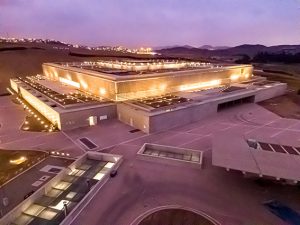July 26th 2021.-
OHLA achieves a new milestone in Latin America. On July 24th, the National Museum of Peru (MUNA) was inaugurated as part of the celebrations held to commemorate the two-hundredth anniversary of the country’s independence.
This construction project represents the largest investment made in the history of Peru, seeking to protect, study and disseminate its rich and vast culture heritage. It is Peru’s largest museum and one of Latin America’s most important.
The building, whose architectural façade is based on a pre-Hispanic reminiscent design, will be harmoniously integrated into its cultural and environmental surroundings. It is located in a site measuring more than 75,000 m2, inside the Pachacámac archeological area, Lurín district, at kilometer point 31 of the former Panamericana Sur highway.
Its execution has involved important innovation and sustainability standards, to include use of the Lean Construction methodology with the Last Planner and Flow Lines tool, as well as BIM implementation to resolve any interferences from its complex facilities and networks and to simulate virtual reality, to assist the technicians assigned with the task.
Constructive milestones
The Museum building has been conceived as a floor quadrangle measuring 126 meters, with a clear and broad structural layout, fully modulated with 9 and 18-meter span corridors, most of which are post-stressed.
The project envisages 128,000 m2 of exposed concrete, partitioned into exposed-concrete block walls. All floors are made of concrete, with Grade 400 exposed and polished aggregate. A total of 7,800 m2 of aluminum-frame partitions have been supplied and installed.
In addition, 90,000 m3 of concrete have been used, as well as 10,500 t of steel and 145,000 m2 of formwork. For its execution, 25 wells more than 18 meters deep have been necessary, using a dewatering system to accordingly reduce the water-table at the construction stage, in addition to a gravity-based hydraulic system, with large-diameter pipes nearly 2 km long.
The unit consists of two clearly separate buildings. On the one hand, the Museum building has three floors below ground (floor -3 under the water-table level), two floors above ground and the top terrace floor. Adjacent to this building is the parking lot and technical building, with two floors below ground; the top roof makes up a large square facing the museum with a highly unique concrete pergola.
The top floors are interconnected with perimeter ramps encircling an open central area, which takes advantage of natural light to enhance its valuable surrounding archaeological assets. The light penetrates through a skylight with a more than 40 m shaft, glassed in on top of structural steel, using a system of automated adjustable slats.
